27.06.2011: CERN welcomes summer visitors
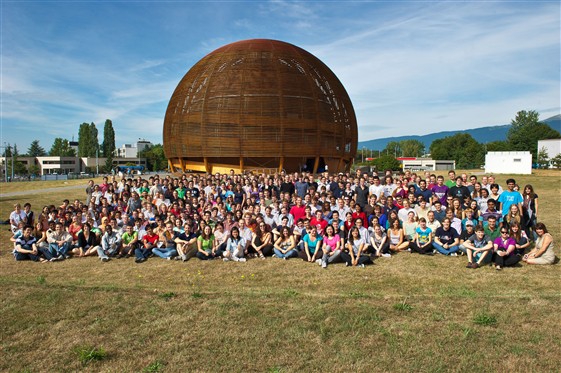
2010's summer students in front of CERN's Globe of Science and Innovation
This year's summer students have begun to arrive at CERN. Every summer CERN welcomes many visitors to student and teacher programmes. CERN also offers year-round programmes for graduate students and fellowship programmes for masters-level graduates.
More information:
- From the archives: Good-bye Summer Students 2009!
- CERN teachers' programme: http://cern.ch/teachers/
- Recruitment at CERN: http://cern.ch/jobs
20.06.2011: Budding scientists in CERN conference
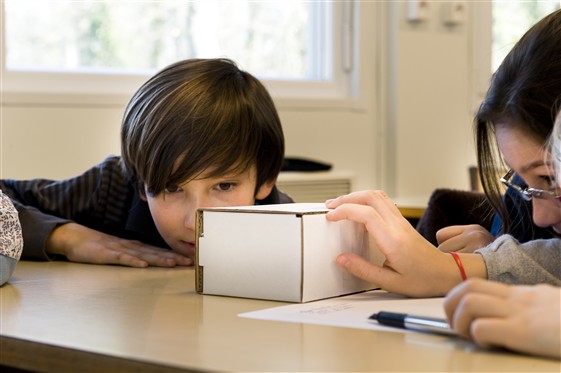
Students participating in the Dans la peau d'un chercheur project devised experiments to explore sealed boxes – in much the same way that physicists explore things that are far too small to see.
Students who took part in the Dans la peau d'un chercheur ("In the shoes of a researcher") project will share their findings during a conference this Friday. Since January some 650 students from neighbouring schools involved in the project have been devising and running experiments using the methods of 'real' researchers to discover the mysterious contents of sealed boxes.
The conference will be webcast (in French) from 1:45pm CEST: http://webcast.cern.ch/
More information:
05.06.2011: ALPHA experiment traps antimatter atoms for 1000 seconds
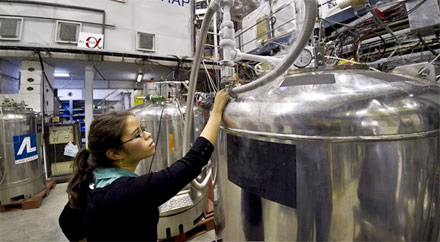
Andrea Gutierrez, a PhD student from UBC, transfers liquid helium from a storage dewar into the cryostat containing the superconducting magnetic trap used by the ALPHA experiment.
In a paper published by Nature Physics, the ALPHA experiment at CERN reports that it has succeeded in trapping antimatter atoms for over 16 minutes: long enough to begin to study their properties in detail. ALPHA is part of a broad programme at CERN's antiproton decelerator investigating the mysteries of one of nature's most elusive substances.
The trapping of antiatoms will allow antihydrogen to be mapped precisely so that it can be compared to the hydrogen atom, which is among the best-known systems in physics.
More information:
31.05.2011: Video: LHC running with 1092 bunches per beam
Cannot see the video? Try viewing it on the CERN Document Server
23.05.2011: LHC Experiments Present New Results at Quark Matter 2011

The three LHC experiments that study lead ion collisions all presented their latest results today at the annual Quark Matter conference, held this year in Annecy, France. The results are based on analysis of data collected during the last two weeks of the 2010 LHC run, when the LHC switched from protons to lead-ions. All experiments report highly subtle measurements, bringing heavy-ion physics into a new era of high precision studies.
“These results from the LHC lead ion programme are already starting to bring new understanding of the primordial universe,” said CERN Director General Rolf Heuer. “The subtleties they are already seeing are very impressive.”
More information
- Press release: LHC Experiments Present New Results at Quark Matter 2011 Conference
- Websites of the three LHC experiments presenting at Quark Matter 2011: ALICE, ATLAS, CMS
20.05.2011: AMS installed on international space station, taking data
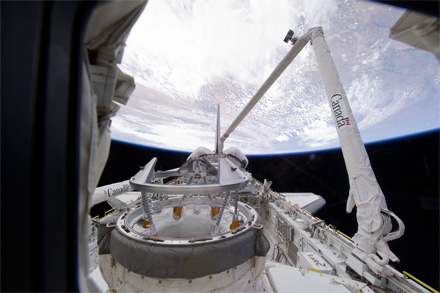
The payload bay of NASA's space shuttle Endeavour is opened in readiness for docking at the International Space Station Image: NASA
The Alpha Magnetic Spectrometer (AMS) detector was yesterday installed as an external module to the international space station just three days after leaving Earth on board the Endeavour space shuttle. The detector is now operational and members of the AMS collaboration have begun to receive data. AMS spokesperson Samuel Ting spoke to the mission crew and thanked them for their exemplary work.
The AMS detector was developed by an international collaboration of over 600 scientists and was assembled at CERN.
More information
16.05.2011: AMS begins journey to international space station
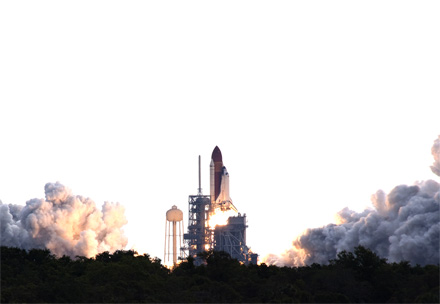
NASA's space shuttle Endeavour taking off on its final mission, STS-134 Image: NASA
NASA's Endeavour shuttle took off today on its final mission carrying the Alpha Magnetic Spectrometer (AMS). The AMS detector will be installed as an external module to the international space station where it will study the Universe and its origin by searching for antimatter and dark matter while performing precision measurements of the composition and flux of cosmic rays.
The AMS detector was developed by an international collaboration of over 600 scientists led by Nobel laureate Samuel Ting and assembled at CERN.
More information
13.05.2011: 16 May: webcast for AMS launch
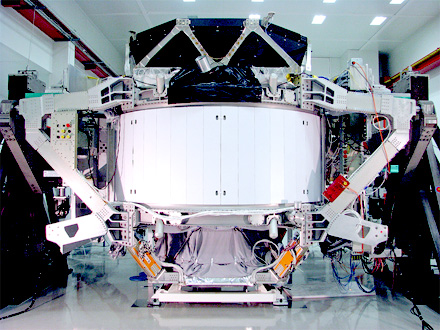
The AMS detector seen in its clean room at CERN - Image courtesy of AMS collaboration
The Alpha Magnetic Spectrometer (AMS) is due to travel into space on board NASA's Endeavour shuttle on 16 May 2011. The AMS detector will be installed as an external module to the international space station where it will study the Universe and its origin by searching for antimatter and dark matter while performing precision measurements of the composition and flux of cosmic rays.
The AMS detector was developed by an international collaboration of over 600 scientists led by Nobel laureate Samuel Ting and assembled at CERN.
Join us for a live webcast between 2:45pm - 3:30pm (Central European Time) Monday 16 May: http://webcast.cern.ch
More information
10.05.2011: Vote for the Google science fair People's Choice award
The Google science fair judging panel has identified the 60 semi-finalist entries, and now it's up to you to decide which project will take home the People's Choice Award. You can vote once in each of the three age-group categories until 20 May at 11:59 PM EST. The People's Choice winner will be announced on 23 May, along with 5 finalists in each age category.
CERN is a partner of the Google science fair.
More information
03.05.2011: 100 years of the nuclear atom
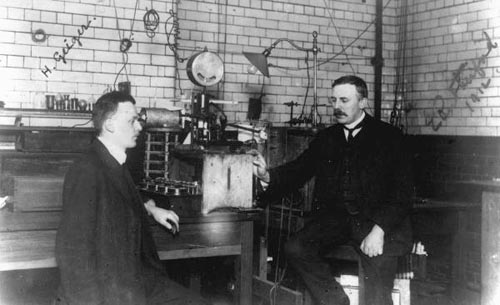
Rutherford, right, in the laboratory at Manchester University with Hans Geiger, around 1912. Image credit: Rutherford family.
This month is the centenary of what is arguably the most amazing discovery of the 20th century – that the apparently solid world around us is mainly empty space.
In May 1911 Philosophical Magazine published a research paper by Ernest Rutherford. He had analysed the results of some measurements by Hans Geiger and Ernest Marsden, who worked with him at Manchester University. The analysis led Rutherford to the conclusion that all the positive electric charge within an atom, and most of the mass, must reside in a tiny central region, with the negatively charged electrons swirling round far away. The central core became known as the atomic nucleus and the study of it led to our understanding of the fundamental particles and forces in the Universe.
More information
- CERN Courier: Rutherford — the road to the nuclear atom
- About Ernest Rutherford: www.rutherford.org.nz
26.04.2011: AMS detector bound for space

NASA's Endeavour space shuttle - Image courtesy of NASA.
The Alpha Magnetic Spectrometer (AMS) is due to travel soon into space on board NASA's Endeavour shuttle. The AMS detector will be installed as an external module to the international space station where it will study the Universe and its origin by searching for antimatter and dark matter while performing precision measurements of the composition and flux of cosmic rays.
The AMS detector was developed by an international collaboration of over 600 scientists led by Nobel laureate Samuel Ting and assembled at CERN.
More information
22.04.2011: LHC sets world record beam intensity
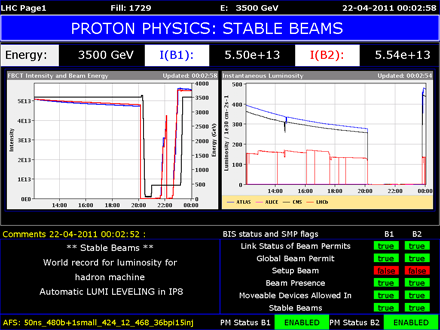
A screenshot of 'LHC Page One' — which displays the status of the accelerator.
Around midnight this night CERN's Large Hadron Collider set a new world record for beam intensity at a hadron collider when it collided beams with a luminosity of 4.67 × 1032cm-2s-1. This exceeds the previous world record of 4.024 × 1032cm-2s-1, which was set by the US Fermi National Accelerator Laboratory’s Tevatron collider in 2010, and marks an important milestone in LHC commissioning.
More information
11.04.2011: 100 years of superconductivity
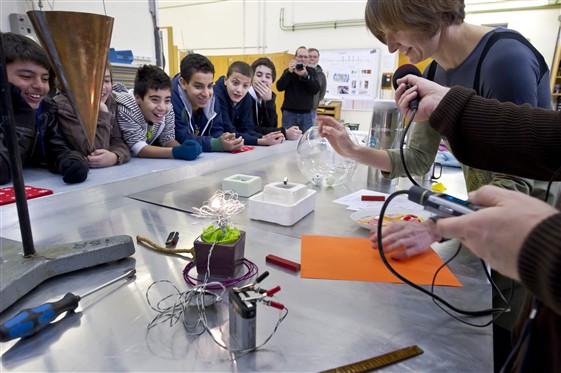
Children visiting CERN witness superconductivity at low temperatures first hand during an experiment.
On 8 April 1911, Heike Kamerlingh Onnes at the University of Leiden in the Netherlands made the momentous discovery of superconductivity. In measuring the electrical resistance of mercury at low temperatures, he found that resistance disappeared completely at temperatures below 4.2K (‑269°C). This revolutionary finding, crowned in 1913 by a Nobel Prize, was to have far-reaching consequences, including applications in health, communications and energy.
CERN makes use of the phenomenon on an unprecedented scale. In the Large Hadron Collider particles are guided around the 27km accelerator ring by strong superconducting electromagnets. These are built from coils of special electric cable that operates in a superconducting state, efficiently conducting electricity without resistance or loss of energy. This requires chilling the magnets to about ‑271°C – a temperature colder than outer space!